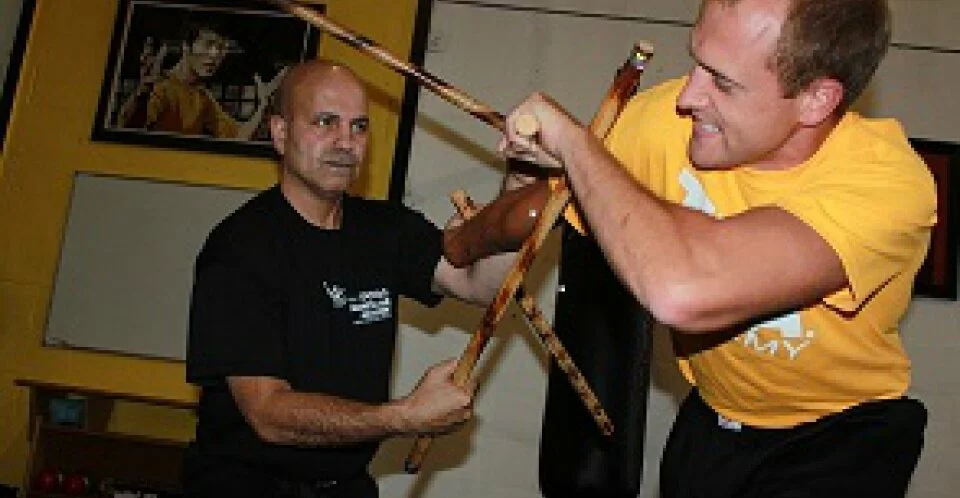
Understanding Kali - 4
Panantukan – Art of Advanced Boxing
By Lakhvinder S. Madahar
Introduction
It was just a normal day where I would be teaching a class or two, holding a private session or two and squeezing an hour or two of my own personal training. Things haven’t change that much, since I gave up my so called craftsmanship as a carpenter, about six years ago. Teaching martial arts hasn’t made me rich, but I am making a living from something I enjoy!
A few years ago, there wasn’t anything out of the ordinary going on either; it was just another day where I did a thing or two. Then on this particular day, it turned out to be an exception, as my whole lesson plan fell flat on its face.
As usual I had prepared my lesson plan mentally, ninety nine point nine percent of the time this worked well for me due to the excellent flexibility of being able to adapt to the students needs.
I made my way to the Kali class at Coventry University, and put my plan into action. The classes there have always been very popular; ever since we started them over ten years ago and many students have personally told me that they felt they got something really worthwhile, a few of them are still with me and many more have stayed in touch, after leaving university.
This time the material consisted of some Pananatukan the Art of Advanced Boxing, with a view to giving the students a good cardio workout followed by some sensitivity drills from Hubad, little double sticks and finish off with the single stick.
Empty Hand Interruption
I began the warm up with the usual warm up routine, followed by the topics of the day. I proceeded to put the students through their phases with some basic Panantukan focus pad drills and I continued with little explanations of Kali’s empty hand skills to the best of my ability, everyone seemed to be taking to it really well.
This worked to a point, where I was suddenly interrupted by a non – university student who started attending my university classes only a month earlier, after his return from a trip in the Philippines. This was where he got interested in the Filipino martial arts, as he saw a demonstration there by one of the Doce Pares groups.
He just pointed out to me, in unpleasant terms, that he had come here to learn Eskrima, and I assured him that it was Eskrima we were practicing, it may not be stick or knife at this moment in time, but it still is Eskrima. He continued with how he felt the classes had too much cardio work and he was fed up with it, if he wanted to do “this punching stuff”, he could have gone to a Kung Fu or to the local Boxing club.
Perhaps at this point I should have shown him the door, but as always my mild manners got the better of me and I provided him the benefit of the doubt. I explained to him with a little more depth than I usually do, the Filipino martial arts of Kali or Eskrima as he liked to call it, is more than just stick fighting and we will be doing it as soon as we’ve had covered the pad work. On this note, I continued with the class and switched to giving a detailed explanation of Panantukan that how it was one of the twelve sub - systems of Kali, for his benefit and the benefit of the class.
Despite my best efforts to convince him, that what he was being taught here was in fact, part of the Filipino martial arts and he would still benefit from this type of training, as a fit Kali man is better then an unfit Kali man. After the class he left without saying anything and choose not to return, may be I should have read something in his silence.
I don’t think I could have done any thing more. I think it was just that his perception of the Filipino martial arts didn’t fit with my lesson plan for the day or my teaching style.
Filipino Boxing
As in last month’s article and in the situation mentioned above, we can see how many Kali students and martial artists in generally are over looking the empty handed arts of kali.
Panantukan is an art of Filipino boxing; some have referred to it as dirty boxing and others as advanced boxing. I personally prefer to call it advanced boxing, as all fighting without a referee, is by nature dirty fighting.
Panantukan techniques are born out of the weaponry movements of the Kali sticks, swords and knives. Weaponry training develops your coordination to the point of rejuvenating the deeply buried motions that have been a sleep beneath the muscle fibres, and are gradually awakened from within through regular practice.
Panantukan resemble western boxing, but then again some will say no its western boxing that resembles Panantukan. Historically, at the turn of the twentieth century, it was Panantukan that introduced the light footwork; the ability to slipping punches, bobbing and weaving. That we all take for granted in our present day western boxing training. Where as the Boxing in the west, during the same period was very flat footed with the palm up extended guard and lacked much of the fast footwork; the skilful slipping and bobbing and weaving.
I’ve used western boxing here, not as a comparison, but as something for Panantukan to relate too, as the two arts are similar in appearance and generally everyone is familiar with western boxing, even though they might be more in tune with the latest Rocky movie, then the present day Heavyweight Champion of the World.
Suntukan – Filipino Boxing
Panantukan was originally known by the term Suntukan, its name was changed due to the confusion this term could have caused with the Okinawa/Japanese Karate style Shotokan. As Guro Dan Inosanto, explained to us at the last year’s seminar.
Panatukan Striking
Panantukan obviously has many techniques that are unique to its own reputes and when they are delivered they create a flavour that’s all their own, but it is the jab, the cross, the left hook, the right hook, the over head punches and the uppercuts, acts as the resin that binds them together.
It also has the inward hammer and backhand hammer slash type of punching blows, usually done diagonally, but not limited to this motion as at times they are delivered horizontally and vertically.
Defanging the Snake
Then there are the famous gunting motions (Scissors motion), or defanging the snake as many people like to call them. This is the motion that is usually used by most instructors to introduce a student to the art of Panantukan. Over the decades the gunting has remained the trademark for Panatukan, it literally does give Filipino Boxing an edge, as it is the very motions from the knife, but not limited to knife work. Gunting simply means a scissor type movement as it describes the motions perfectly.
As mentioned above, about Panantukan’s introduction through the gunting techniques, my earliest memory of Panantukan is also the gunting. It was at Guro Dan’s first weekend seminar where he showed us the technique and asked us to get our partners to hit the incoming arm (Jab) ten times with the extended knuckle, using the gunting motion, so we could gain a better understand of it and appreciation. As a result, my elbow area was blue for about a week.
On my way back from the seminar, I remember thinking to myself, I’ve seen more martial arts in one weekend then I probably had in the previous ten years. The gunting was one of the main things stuck in my mind, I couldn’t wait to get back to my regular classes to try out the gunting and many of the other leg destructions I had learned, I felt I could beat anyone in the club and I did catch a few of them.
Since then there has been a lot said about the gunting’s effectiveness and its ranges. At one point only the hand hitting the elbow (funny bone or crazy bone) of the opponents arm was considered the gunting range and obviously its effectiveness was limited. In a nutshell, the guntings are applied at close range, middle range and long range. Gunting is one of the many concepts from the Filipino martial arts; there for it is applied all through the impact weapons ranges, the edged weapons ranges and course the empty hand ranges.
Opponent’s Body Manipulation
The manipulation concept is where the hands are used to grip the opponent’s arms, legs and neck. Manipulation is achieved by pulling, pushing or circling the limbs, these off balances and disorients the opponent before the power shots are unloaded on to him.
Angling and Zoning
Angling is achieved by the complex footwork patterns practice in conjunction with the other sub – systems of Kali. There are many footwork patterns in Kali covering the lateral lines, vertical lines, diagonal lines, quarter turn, semi circler or 180 turns, three quarter turns and of course the three sixty turns. This allows the Panantukan man/woman to move to safety and all so counter from a safer position.
Limitations Equals
Hopefully by now, it’s beginning to paint a pretty colourful picture of Panantukan and its rich contents of principles, concepts, and of course techniques. As a closing note western boxing is the way it is, due to the Queensbury rules there is certain area on the body that is used as the valid target and the weapons striking area is also limited by the same rules. When you have these limitations, it equals western boxing and removal of all limitations will not equal to Panantukan, as there is more!
As Rick Faye put’s it “the art is complete but never finished”, Panantukan is very complete but remains unfinished for you until you add your own flavour.
Recommend Viewing and Reading
I’d recommend Rick Faye’s book and DVD’s on the Filipino Boxing Art – A Guide to Panantukan. Guro Dan has a Panatukan and Dumong DVD’s out, which will keep any busy for a long time. There is also some DVD’s out by Rick Young and Bob Breen that cover aspect from Kali’s, kicking, boxing, trapping and grappling.
Conclusion
Thank you for reading this article, hope you enjoyed it. Each month I will be covering a topic, on various weapons, empty hands, concepts and principals that govern the Filipino martial arts and some actual techniques will also be discussed. If you have any comments or questions, feel free to drop us a line.
www.thaiboxing-coventry.co.uk
For more information on; Personal one on one session, group sessions or training at
Total Martial Arts Academy
Stag Industrial Estate,
Unit B1 Endemere Road
Coventry.
Call Lucky Madahar mobile 07834767487
Email: [email protected]







